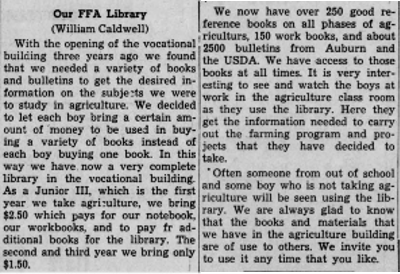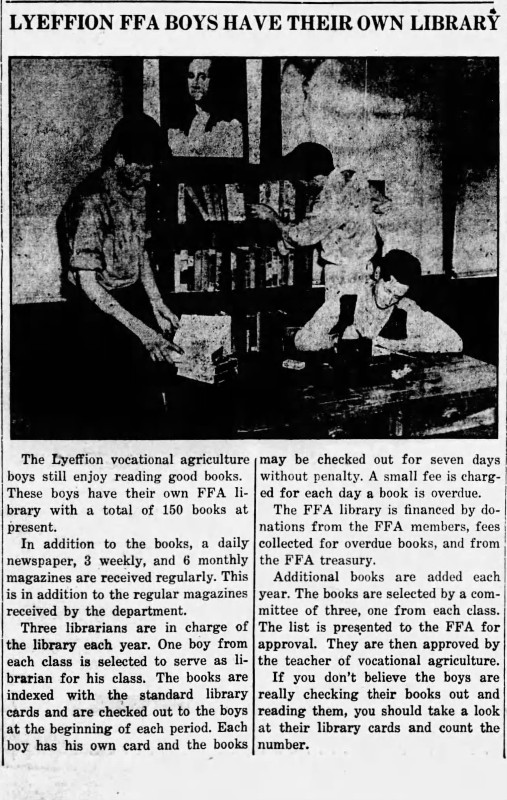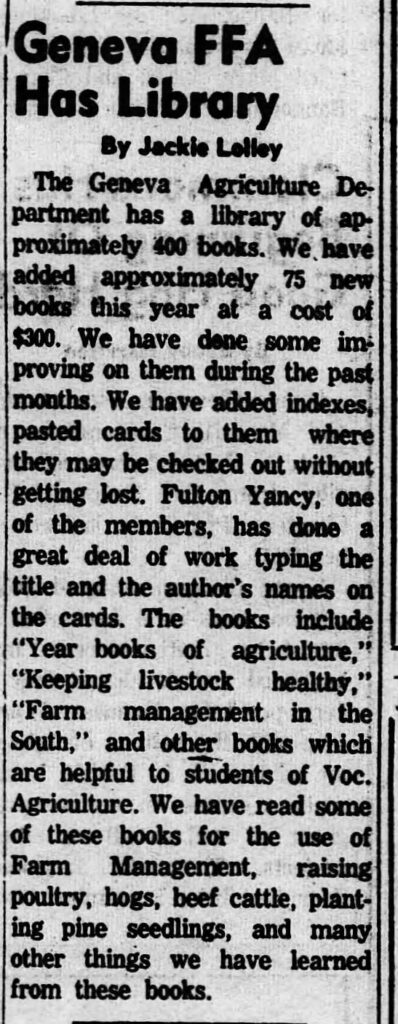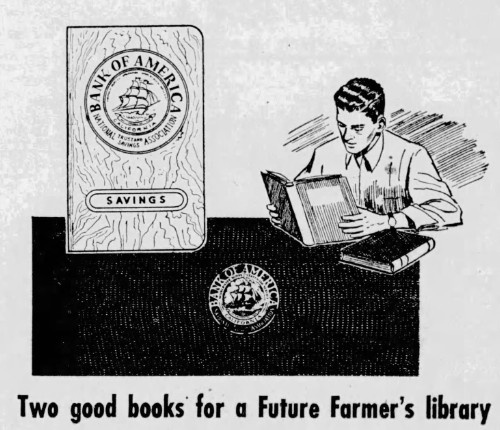Would an article in the newspaper about the FFA (Future Farmers of America) library qualify as breaking news? Apparently so. When one searches Newspapers.com (a site that indexes over 22,100 newspapers) there are numerous hits for the search term “FFA library.”
In a recent Friday Footnote we learned that having a FFA chapter library was a goal in the National FFA Organization’s Program of Work (POW) from 1936 To 1960. The number of FFA chapters with libraries rose from 2,257 in 1935 to a high of 7,956 (which was 88% of the FFA chapters) in 1957. After 1960 the National FFA stopped keeping track of the number of FFA chapter libraries.
In this Footnote we will learn more about the books in the FFA library and the operation of these libraries. Numerous newspaper articles contained minutes of recent FFA meetings indicating the chapter had voted to expend money buying additional books, but other articles contained much more interesting information. Most of the information that follows was taken verbatim from newspaper articles. Occasionally the newspaper article has been summarized.
Newspaper articles from the 1930s
Alabama – A thorough study of first aid was made by the Cedar Bluff FFA chapter this year with the result that every member was qualified by the end of the year to give first aid in ordinary emergencies. Two copies of the “The American Red Cross First Aid Manual” were added to the FFA library and a complete first aid kit was bought by the Chapter. – The Wetumpka Herald, June 4, 1936.
Nebraska -The F.F.A. library is now a reality; there are fifty-two books in the library. It is in the agriculture room of the high school. A few of the books are on the book report list of the high school. Almost all of them are by good writers and might well be included on the book reports list. – The Fairbury News and Gazette, November 26, 1936.
Louisiana – The Pollock FFA chapter … received an award for having the best FFA library in the district. – The Town Talk, June 10, 1939. Alexandria.
Texas – The library of the Bishop Future Farmers of America received a set of encyclopedias as a Christmas gift from August H. Theiss, well known Bishop Farmer. – Corpus Christi Caller-Times. December 31, 1939.
Newspaper articles from the 1940s
Missouri – Using a twenty-five dollar donation from Dr. Paul F. Cole for the purchase of a collection of books on agriculture, the Future Farmers of America, LaBelle Chapter, has started a library to be known as the Cole FFA Library. The case to hold the books has been constructed in the farm shop at the high school and installed in the study room of the Vocational Agriculture department. Books to be placed in the library will not be text books, but volumes of general interest to young people, studying agriculture and the problems of rural life. – November 28, 1941.
Alabama – Figure 2. The Greensboro Watchman. April 23, 1942

Texas – A new Bible was bought with Alpine FFA chapter funds and placed in the FFA library. – San Angelo Standard-Times. June15, 1945.
Illinois – It was also decided at the FFA meeting to add a new book “Public Speaking for Future Farmers” to the FFA Library. – November 8, 1945, Mount Carmel.
Missouri – A recent addition to the FFA library at T.H.S. is a bulletin entitled “Cattle Grubs Must Go” which was published by the National Livestock Loss Prevention Board, Chicago, Ill. The booklet tells not only about the damage done to cattle (in damage to hides and in lowering vitality), but also about the infestation of people, particularly children (several cases of which are reported each year) by the grub. Most people locally referred to these grubs in cattle as “wolves in the back.” Last winter, M. Alderman, who lived 3 miles north of Tuscumbia, reported the finding of between 50 and 100 grubs in the back of a calf that was noticeably stunted in growth. – The Miller County Autogram-Sentinel, January 4, 1945.
Wisconsin – Freshman of the Seymour FFA will sell milk in the high school assembly during the noon hour to raise funds with which to purchase an FFA banner. Sophomores will buy 55 FFA manuals to be kept in the FFA library. – The Appleton Post-Crescent, October 25, 1945.
Oklahoma – The F.F. A. Library which consists of sixteen volumes was created the 3rd week of school. This chapter believes it will be the largest and most outstanding of its kind in the state by the end of the semester, as all the books are in continuous use and duplicate orders have been placed for them. – Haskell County Tribune, October 18, 1945. Stigler.
Pennsylvania – The Hollidaysburg FFA voted to purchase five fiction books to be added to the FFA library. The chapter library is made up of fiction and non-fiction books dealing with rural life. Altoona Tribune, November 29, 1949.
Louisiana – “Defense Bonds for FFA Library to Be Purchased.” That was the heading of a story about the Leonville FFA. The FFA members voted to sell defense stamps with the proceeds being used “for the sole benefit and bettering the FFA Library in ten years” when they were cashed. – Clarion News, March 12, 1942. Opelousas.
Alabama – Figure 3. Article from The Evergreen Courant, May 20, 1943.

Missouri – The April 6, 1944 edition of the Seymour Citizen newspaper in Missouri featured an article titled “Vocational Ag. Projects.” The Production projects and Improvement projects of the Seymour High School vo-ag students were featured. Of the 28 students listed in the article. 17 had established a home Ag. Library as improvement projects.
Newspaper articles from the 1950s
South Carolina – The winning land judging team in the Anderson FFA Federation was the Crescent chapter. The received a $50 award from the Anderson FCX to be used for the FFA library. The Greenville News, November 8, 1956.
California – A library can also have films. The Tribune of San Luis Obispo (March 26, 1954) reported “The state Future Farmer film library located on the campus of Cal Poly and serving 225 high schools and 10 junior colleges offering vocational agriculture in the state received a boost this week with the addition of eight sound films of interest to teen age boys…The library now lists nearly 200 different pictures, principally on technical agriculture subjects, and operates on a non-profit service basis.”
Missouri – Three films on record keeping were bought for the FFA library to help freshmen and sophomores to better understand how to keep their record books up to date, neat and in order. – Moberly Monitor-Index, November 20, 1957.
Kansas – A. P. Davidson, Head of Agricultural Education at Kansas State College wrote a 15 year history of the FFA in Kansas and then later wrote a 25-year ”History of FFA in Kansas.” These two publications are now “a part of the FFA library in every vocational agriculture department in Kansas.” – The Manhattan Mercury, September 30, 1956.
Missouri – The Ozark FFA chapter completed a 2,386 mile tour during the summer of 1955. While visiting the U.S. Senate they were given two books by Senator Estes Kefauver’s staff to be placed in their FFA chapter library. – Springfield Leader and Press, June 5, 1955.
Alabama – Figure 4. Article from the Geneva County Reaper, February 26, 1959.

Alabama – The FFA chapter library is well equipped with approximately one hundred forty-four books. Some of the books that are available in the chapter library are: “Reporting FFA News” by Charles E. Rogers; “Young Men in Farming” by Getman and Chapman; “America Begins Again” by Katherine Glover; “Peace Valley Warrior” by John Francis Case; “Programs for Future Farmers” by Arthur Kendall Getman and “Forward FFA” by W. A. Ross. – St. Clair News Aegis, February 28, 1952, Pell City.
Oklahoma – The Pioneer Club of Atoka, Oklahoma donated their collection of agricultural books to the Atoka FFA in 1958. The books were worth over $200 and were concerned with plant ecology, field crop production, beef cattle production, plant diseases, forestry, general zoology, small fruit culture, forage crops and pastures, soil science, plus six other areas of agriculture. According to the Jeffersonian newspaper of Atoka (January 23, 1958, p. 4) “The books will be placed in the agriculture reading room and be used for reference books by the teachers and by the students for working up special assignments and doing research. [Curator’s Note: The Atoka Pioneer Club was founded as a women’s club in 1896 and was in Indian Territory. Most of the members including the first president were of American Indian descent.]
California – Figure 5. Stockton Evening and Sunday Record, May 11, 1957. The image below mentions “a Future Farmer’s Library” and appeared in several California newspapers in 1957. This was an advertisement for Bank of America and the two books mentioned in the ad were a savings book and a checkbook. It appears the Bank of America was aware of FFA libraries. The advertisement has been cropped to conserve space.

Concluding Remarks
It is obvious from these newspaper articles that FFA chapter libraries were important in the earlier days of the FFA. There was a wide variety of books in the libraries. The libraries were supported by individuals in the community and were utilized by the students. Students could even start a home library as a part of their Supervised Agricultural Experience (SAE) program.
I know that times and technology change, but I wonder if any FFA chapters formally operate libraries today. If your FFA chapter still actively maintains a FFA library or conducts special activities to encourage your members or people in your community to read, I would like to know about it. Please drop me a note at gmoore@ncsu.edu. Your responses will be the basis for an upcoming Friday Footnote.
This Footnote deliberately looked at newspaper articles about FFA libraries published prior to 1960. Having a chapter FFA library disappeared from the National FFA Program of Work in 1961. So, did articles about FFA libraries start to also disappear from the newspapers in the 1960s and in the following decades? Next week we will answer that question. Stay tuned.
